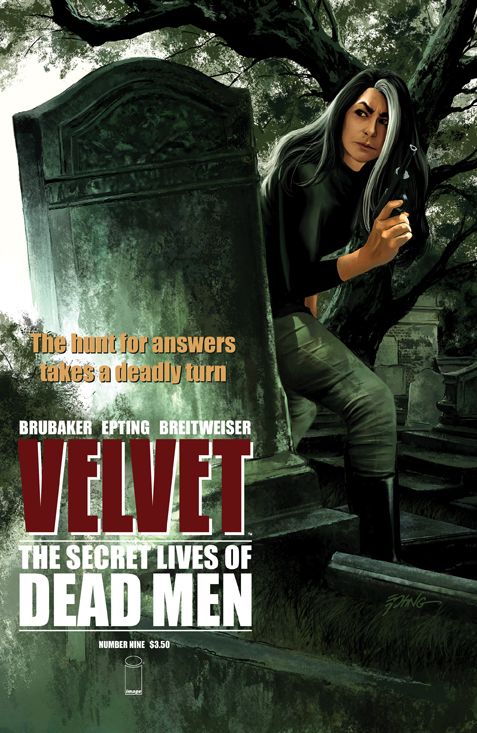"Velvet" #9 by Ed Brubaker and Steve Epting opens with two agents reconstructing the scene of a car crash and abduction. This kind of time jump can loosen suspense, but Brubaker stretches out the scene, allowing the art to handle the storytelling, and thus the action stays taut. Epting tilts the panels slightly on the first page, just enough to reinforce the forward motion without calling too much attention to the technique. The detail he puts into the crushed vehicle looks great, especially how the twisted metal is nestled in soft grass that is wet with rain. Far from being daunted, Epting seems further energized by the challenge of opposing textures and multiple characters in one scene.
Breitweiser's colors are exceptional in the opening scene as well. Her palette indicates the time lag between Velvet and Agents Colt and Roberts but without disrupting the panel flow. The puffs of red and yellow light around the sirens and in front of the headlights add realism and beauty as well.
Brubaker's spare, sharp-edged dialogue in the first scene makes a great contrast for the return to Velvet's warmer narrative voice, which handles a flashback. It's an information dump, but Brubaker keeps it short and precise, like a recited dossier.
The rest of "Velvet" #9 is all talking heads, but Velvet and Damian Lake's conversations are a rare progression from verbal chess to banter between soldiers. The result is that the dialogue is fascinating for its changing mix of chummy vulnerability and canny manipulation. Epting's facial expressions and body language are excellent here as he opens up the characters' faces with smiles and more relaxed postures. It's great how he can make both Velvet and Damian look hard and difficult to crack in their first exchange and then soften them up as they talk on the train. Breitweiser assists with her palette transitions from cold to warm tones.
Damian Lake himself technically made his first appearance last issue, but "Velvet" #9 is the first time readers see him talk. He's still shrewd and sharp despite years of confinement in an asylum, not to mention likable and charming in a gritty way. For foreshadowing and also just to throw a cold glass of water on the reader, Brubaker splices in a scene between Colt and Roberts, calling into question Lake's version of events. The content of the scene is ho-hum but does the job of raising doubt, and Epting and Breitweiser make the smooth transitions look easy.
The only disappointment is the last page cliffhanger. While executed with appropriate drama by the art team, it doesn't fit in with Velvet's characterization. It seems unlike her to make such a rookie mistake. It's difficult to swallow, even though Brubaker tried to pave the way by showing how Lake was creating a false sense of ease in Velvet with seeming camaraderie.
Velvet's credibility as a tough, smart operator suffers here from Brubaker's need to keep the action moving forward. While this well-worn plot twist was probably inevitable, given that Lake isn't an open book, it comes too soon. Also, "Velvet" #9 feels more lightweight than many previous issues, since the characterization is focused on Damian more than Velvet or her pursuant agents. The flawed ending is more a blip than a dip in quality, though. "Velvet" remains a gripping, rewarding read for its narrative construction and art.

